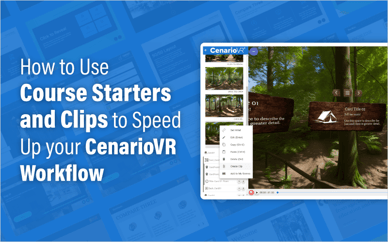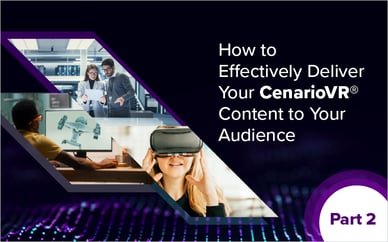Modern organizations have started to embrace virtual reality; more and more are looking to include it as part of their training programs. CenarioVR® provides a very simple, yet powerful solution to help organizations ramp up their immersive learning initiatives.
However, most organizations still worry and wonder about how they will get their content to their learners. Common questions include:
- Will their new VR content work on their existing LMS?
- Do they need a whole new system?
- Do they need to invest in VR headsets like the Meta Quest 2?
- Will the existing hardware their organization already has be sufficient?
There isn’t one correct answer to these questions. Much depends on your company policies and your budget. Luckily, the answers to these questions can change over time as your company’s journey into immersive learning continues.
There are some distinct advantages and disadvantages to all the different options you have. Over this two-part blog series, I’ll discuss these questions and associated pros and cons in great detail.
In today’s article, I cover the different ways the learner will experience VR content depending on the device options chosen and the inherent advantages and disadvantages of that experience.
Computers
Computers are probably the simplest and most readily available platform to experience VR content. When a learner takes a CenarioVR scenario on a desktop or laptop computer, the experience runs in a browser but does have the ability to go full screen, which ups the immersion for the user by getting rid of other distractions from the browser window. They use their mouse or arrow keys to navigate the scenario and interact with the environment.
This is a very easy-to-understand way to navigate the scenario. That being said, navigating with a mouse doesn’t really simulate the ability for the user to look around and take in the whole scenario in a fully immersive way. Another potential drawback is that in most cases taking the scenario on a computer will also rely on the learner’s internet connection. If this connection isn’t great, the learner could experience lag or other loading issues.
Note: There is a Windows Offline publish option available to help combat this issue. That will be discussed more in part two of this series.
Mobile Devices
CenarioVR also allows learners to use their mobile devices such as smartphones and tablets to experience scenarios.
Most mobile devices and tablets have gyroscopes built in that your scenario can tap into so as your user moves their device they can look around and experience the whole scenario. In addition to the gyroscopes, or if they are not available, the learner can navigate with their fingers similar to navigating with a mouse on the computer. In either option, they will tap on any hotspots or other interactive elements with their fingers to make a selection.
While CenarioVR scenarios can still run within a browser on mobile devices, we also offer a CenarioVR mobile app on both Android and iOS/iPadOS devices, which allows your learner to run the scenario locally on their device, without reliance on an internet connection. This is a much better experience as opposed to running it in the browser on the mobile device.
Potential drawbacks here are similar to those when using a computer. Tapping and navigating with your fingers is very similar to navigating with a mouse and so the immersion in the scenario may suffer a little bit. But overall I think this option strikes a nice balance for an organization that is looking to get a bit closer to the experience of full immersion in the form of VR headsets.
VR Headsets
Virtual reality headsets are by far the most immersive form of delivery for your CenarioVR content. As your learner turns their head with the headset on they can look around the space. Selecting hotspots with the controllers feels a lot more like touching the real world than any of the other options. Not to mention you can utilize spacial audio to up the immersion and simulate sounds coming from different directions.
When using the headset it is highly recommended to use the CenarioVR app on the supported headset. Similarly to the mobile device app, this allows you to run the scenario locally using the device hardware. However, scenarios can still be loaded in the browser using the controllers on the headset thanks to WebXR functionality built into all CenarioVR publishes. This option does risk potential difficulty with internet bandwidth causing lag and other issues.
Now let’s talk about the downsides of using headsets. There are two main things to consider when looking into using headsets:
- Cost
- Physical limitations on learners
First, let’s talk about cost. Headsets have come down in price over the years but they are still not cheap and typically most organizations will want to have more than one headset to use for training, which multiplies the cost. You’ll want to factor this cost into your plans. Pricing and availability vary quite widely depending on headset and manufacturer. We have an up-to-date list of all supported headsets on the ELB Learning Website, so you can explore which one fits your needs and budget.
There are a number of people, myself included, that will prefer not to use a VR headset due to some physical limitations. Most often the problem tends to be with motion sickness when using the headset which can lead to dizziness and disorientation once the headset is removed. In fact, most people I’ve talked to that have used a headset for an extended period do tend to feel disoriented when the headset is removed. This is also why we recommend making sure your scenarios aren’t terribly long if the plan is to use headsets.
Overall though, even with some of these challenges, headsets still present the most true-to-life experience for experiencing immersive learning experiences.
These are just a few considerations to take into account when determining the best delivery method for your CenarioVR content. I personally think that all are effective and have their places. If your organization is just starting to implement virtual reality, delivering on a computer or mobile device gets you started on the right path. Then when you're ready to take it to the next level, giving users access to headsets as an option creates an awesome experience.








